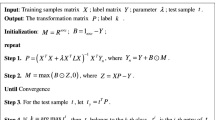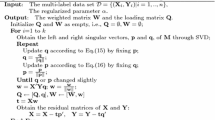Abstract
Multiclass classification is a challenging task in the field of pattern recognition. Recently, linear regression (LR) and a number of its variants play a key role in classification problems. However, most of these methods manage to transform the training samples into a rigorous binary label matrix, which result in little freedom to fit the samples adequately. In addition, these variants cannot obtain a robust classification performance when dealing with noisy and contaminated data. In order to address the problems, we propose a new learning framework, which holds the following extraordinary advantages. First, a negative ε dragging technique is introduced to release the binary label matrix, which has more freedom to fit the samples and reduces the class margins between different classes for getting robust results from noisy data. Second, the manifold learning, as a regularized item, is applied to construct the class compactness graph, which can prevent the overfitting problem. In this paper, the proposed algorithm is designed based on the ℓ2, 1-norm loss function as it takes both superiorities of the systemic representation of ℓ2-norm and the discriminative nature of the ℓ1-norm. A large number of experiments show that our method has a good performance.









Similar content being viewed by others
References
Bemporad A (2016) A quadratic programming algorithm based on nonnegative least squares with applications to embedded model predictive control. IEEE Trans Autom Control 61(4):1111–1116
Cao J, Lin Z (2015) Extreme learning machines on high dimensional and large data applications: a survey. Math Probl Eng 2015:1–13
Cao J, Zhao Y, Lai X et al (2015) Landmark recognition with sparse representation classification and extreme learning machine. J Franklin Institute Eng Appl Math 352(10):4528–4545
Chen C, He B, Ye Y et al (2016) The direct extension of ADMM for multi-block convex minimization problems is not necessarily convergent. Math Program 155(1):57–79
Cohen A, Migliorati G (2017) Optimal weighted least-squares methods. SMAI J Comput Math 3:181–203
Davis D, Yin W (2017) Faster convergence rates of relaxed Peaceman-Rachford and ADMM under regularity assumptions. Math Oper Res 42(3):783–805
Deng Y-J, Li H-C, Pan L, Emery WJ et al (2018) Modified Tensor Locality Preserving Projection for Dimensionality Reduction of Hyperspectral Images. IEEE Geosci Remote Sens Lett 15(2):277–281
Du B, Zhang M, Zhang L et al (2017) PLTD: patch-based low-rank tensor decomposition for hyperspectral images. IEEE Trans Multimedia 19(1):67–79
Du L, Zhou P, Shi L et al (2015) Robust multiple kernel K-means using ℓ 2;1 -norm, Int Conf Art Intell:3476–3482
Fang X, Xu Y, Li X et al (2015) Learning a nonnegative sparse graph for linear regression. IEEE Trans Image Process 24(9):2760–2771
Fernández-Delgado M, Cernadas E, Barro S et al (2014) Do we need hundreds of classifiers to solve real world classification problems. J Mach Learn Res 15(1):3133–3181
Georghiades AS, Belhumeur PN, Kriegman DJ (2001) From few to many: illumination cone models for face recognition under variable lighting and pose. IEEE Trans Pattern Anal Mach Intell 23(6):643–660
He K, Peng Y, Liu S et al (2020) Regularized negative label relaxation least squares regression for face recognition. Neural Process Lett 51(3):2629–2647
Huang GB, Mattar M, Berg T, Learned-Miller E (2008) ‘Labeled Faces in the Wild: A Database for Studying Face Recognition in Unconstrained Environments’, Workshop on Faces in ‘Real-Life’ Images: Detection, Alignment, and Recognition
Huang X, Qiao H, Zhang B et al (2018) Supervised Polarimetric SAR image classification using tensor local discriminant embedding. IEEE Trans Image Process 27(6):2966–2979
Jiang Z, Lin Z, Davis LS (2013) Label consistent K-SVD: learning a discriminative dictionary for recognition. IEEE Trans Pattern Anal Mach Intell 35(11):2651–2664
Kan M, Shan S, Zhang H et al (2016) Multi-view discriminant analysis. IEEE Trans Pattern Anal Mach Intell 38(1):188–194
Lai Z, Xu Y, Jin Z et al (2014) Human gait recognition via sparse discriminant projection learning. IEEE Trans Circ Syst Video Technol 24(10):1651–1662
Lazebnik S, Schmid C, Ponce J (2006) Beyond bags of features: spatial pyramid matching for recognizing natural scene categories. Comput Vision Patt Recogn 2:2169–2178
Łȩski J (2003) Ho--Kashyap classifier with generalization control. Pattern Recogn Lett 24(14):2281–2290
Liu G, Lin Z, Yan S et al (2013) Robust recovery of subspace structures by low-rank representation. IEEE Trans Pattern Anal Mach Intell 35(1):171–184
Liu Z, Wang J, Liu G et al (2019) Discriminative low-rank preserving projection for dimensionality reduction. Appl Soft Comput 85:105768
Liu Z, Lai Z, Ou W et al (2020) Structured optimal graph based sparse feature extraction for semi-supervised learning. Signal Process 170:107456
Luo D, Ding C, Huang H (2010) Towards Structural Sparsity: An Explicit l2/l0 Approach. Int Conf Data Mining:344–353
Martinez AM (1998) The AR face database
Nie F, Huang H, Cai X et al (1813-1821) ‘Efficient and robust feature selection via joint ℓ2,1-norms minimization’. Neural Inf Process Systems, 2010, pp
Nie F, Wang H, Huang H et al (2013) Adaptive loss minimization for semi-supervised elastic embedding. Int Joint Conf Artif Intell:1565–1571
Peng Y, Liu S, Lei T et al (2018) Negative ε dragging technique for pattern classification. IEEE Access 6:488–494
Peng Y, Sehdev P, Liu S et al (2018) l2,1-norm minimization based negative label relaxation linear regression for feature selection. Pattern Recogn Lett 116:170–178
Raghavendra U, Acharya UR, Fujita H et al (2016) Application of Gabor wavelet and locality sensitive discriminant analysis for automated identification of breast cancer using digitized mammogram images. Appl Soft Comput 46:151–161
Song K, Nie F, Han J et al (2017) Parameter free large margin nearest neighbor for distance metric learning’. Nat Conf Artif Intell:2555–2561
Sun L, Ji S, Ye J (2016) Partial Least Squares:43–62
Tang Y (2007) Zhang, Y-Q., Huang, Z.: ‘development of two-stage SVM-RFE gene selection strategy for microarray expression data analysis’. IEEE/ACM Trans Comput Biol Bioinform 4(3):365–381
Wang W, Aggarwal V, Aeron S (2018) Tensor train neighborhood preserving embedding. IEEE Trans Signal Process 66(10):2724–2732
Wen J, Lai Z, Zhan Y et al (2016) The L2,1-norm-based unsupervised optimal feature selection with applications to action recognition. Pattern Recogn 60(60):515–530
Xiang S, Nie F, Meng G et al (2012) Discriminative least squares regression for multiclass classification and feature selection. IEEE Trans Neural Netw 23(11):1738–1754
Xu Y, Lu Y (2015) Adaptive weighted fusion. Neurocomputing 168:566–574
Xu Y, Li X, Yang J et al (2014) Integrating conventional and inverse representation for face recognition. IEEE Trans Syst Man Cybern 44(10):1738–1746
Xu Y, Fang X, Li X et al (2014) Data uncertainty in face recognition. IEEE Trans Syst Man Cybern 44(10):1950–1961
Yan S, Xu D, Zhang B et al (2007) Graph embedding and extensions: a general framework for dimensionality reduction. IEEE Trans Pattern Anal Mach Intell 29(1):40–51
Zhang Y, Zhang Z, Qin J et al (2018) Semi-supervised local multi-manifold Isomap by linear embedding for feature extraction. Pattern Recogn 76:662–678
Zhang Z, Li F, Zhao M et al (2017) Robust neighborhood preserving projection by nuclear/L2,1-norm regularization for image feature extraction. IEEE Trans Image Process 26(4):1607–1622
Zhu B, Liu JZ, Cauley SF et al (2018) Image reconstruction by domain-transform manifold learning. Nature 555(7697):487–492
Acknowledgments
This work is supported by the National Natural Science Foundation of China (No.61873155), Transfer and Promotion Plan of Scientific and Technological Achievements of Shaanxi Province (No.2019CGXNG-019), the National Natural Science Foundation of Shaanxi Province (No.2018JM6050).
Author information
Authors and Affiliations
Corresponding author
Ethics declarations
The authors declare that they have no known competing financial interests or personal relationships that could have appeared to influence the work reported in this paper.
Additional information
Publisher’s note
Springer Nature remains neutral with regard to jurisdictional claims in published maps and institutional affiliations.
Rights and permissions
About this article
Cite this article
He, K., Peng, Y., Liu, S. et al. Regularized label relaxation with negative technique for image classification. Multimed Tools Appl 81, 41131–41149 (2022). https://doi.org/10.1007/s11042-022-12417-x
Received:
Revised:
Accepted:
Published:
Issue Date:
DOI: https://doi.org/10.1007/s11042-022-12417-x




